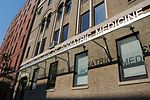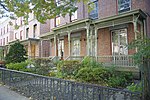Langston Hughes House
1869 establishments in New York (state)HarlemHouses completed in 1869Houses in ManhattanHouses on the National Register of Historic Places in Manhattan ... and 4 more
Italianate architecture in New York CityManhattan Registered Historic Place stubsManhattan building and structure stubsNew York City Designated Landmarks in Manhattan

Langston Hughes House is a historic home located in Harlem, Manhattan, New York City. It is an Italianate style dwelling built in 1869. It is a three story with basement, rowhouse faced in brownstone and measuring 20 feet wide and 45 feet deep. Noted African American poet and author Langston Hughes (1902-1967) occupied the top floor as his workroom from 1947 to 1967.It was listed on the National Register of Historic Places in 1982, and was designated as a city landmark by the New York City Landmarks Preservation Commission in 1981.
Excerpt from the Wikipedia article Langston Hughes House (License: CC BY-SA 3.0, Authors, Images).Langston Hughes House
East 127th Street, New York Manhattan
Geographical coordinates (GPS) Address Nearby Places Show on map
Geographical coordinates (GPS)
| Latitude | Longitude |
|---|---|
| N 40.807222222222 ° | E -73.940833333333 ° |
Address
East 127th Street 12
10035 New York, Manhattan
New York, United States
Open on Google Maps








